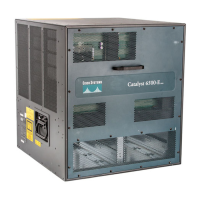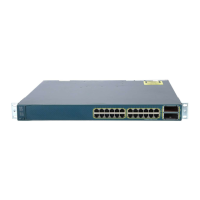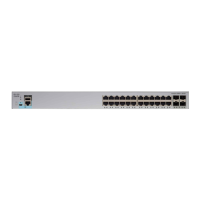10-20
Catalyst 6500 Series Switch Software Configuration Guide—Release 8.7
OL-8978-04
Chapter 10 Configuring VTP
Understanding How VTP Version 3 Works
• When you move from VTP version 1 to VTP version 3, the VLAN database and MST database are
not deleted but they are marked invalid because they have been generated by a VTP version 1 server,
not by a VTP version 3 primary server.
• If you move a VTP version 3 server with a valid database to transparent mode, you can configure
the VLAN database and MST database, but as soon as the database is modified, it becomes invalid.
This situation prevents the switch from going back to server mode and advertising the database
because the valid database that is received from the network overwrites the changes made while in
transparent mode. If a server moves to transparent mode and then back to server mode with no
changes to the database configuration, its database is still valid.
• If you modify a database on a primary server (such as a VLAN configuration), the database stays
valid and is advertised to the rest of the domain. In any mode, when you configure a domain-related
parameter (such as the domain name, VTP version, and the authentication method [password]), all
the databases become invalidated. In addition to invalidating the databases, configuring a
domain-related parameter also reverts a primary server to a secondary server.
• When you change a domain parameter, the switch is inserted into a new domain. To prevent the wrong
database from accidentally being inserted into a VTP domain, you cannot insert a switch as a primary
server into a new domain because it could potentially erase a valid configuration. Because it has an
invalid database, a newly inserted switch in a domain immediately accepts the network configuration
instead of erasing it.
Database Revision Number
Each VTP instance is associated with a database revision number. The database revision number is
incremented when the value of the database that is covered by the advertised checksum is modified.
When a device receives a VTP advertisement from the same primary server for an instance in the same
domain, the following occurs:
• If the database revision number in the advertisement is less than that of the receiving device, the
advertisement is ignored and a summary advertisement with the current revision number is
transmitted on the trunk on which the original advertisement was received.
• If the database revision number in the advertisement is the same as that of the receiving device, the
following occurs:
–
If the checksum of the advertisement is exactly the same as the checksum of the current
configuration known to the device, then no action is taken.
–
If the checksum of the advertisement is not exactly the same as the checksum of the current
configuration known to the device, the device’s configuration is unaffected, but the device
indicates to the database manager that a configuration error condition has occurred.
• If the database revision number in the advertisement is greater than that of the receiving device, and
the advertisement’s checksum and configuration information match, the receiving switch requests
the exact subset of databases for which it is not up to date.
The VTP advertisement is regenerated on each of the trunk ports of the device but not on the trunk port
on which it was received.
Interaction with VTP Version 1 and VTP Version 2
VTP version 3 interacts with VTP version 1 and VTP version 2 switches as follows:

